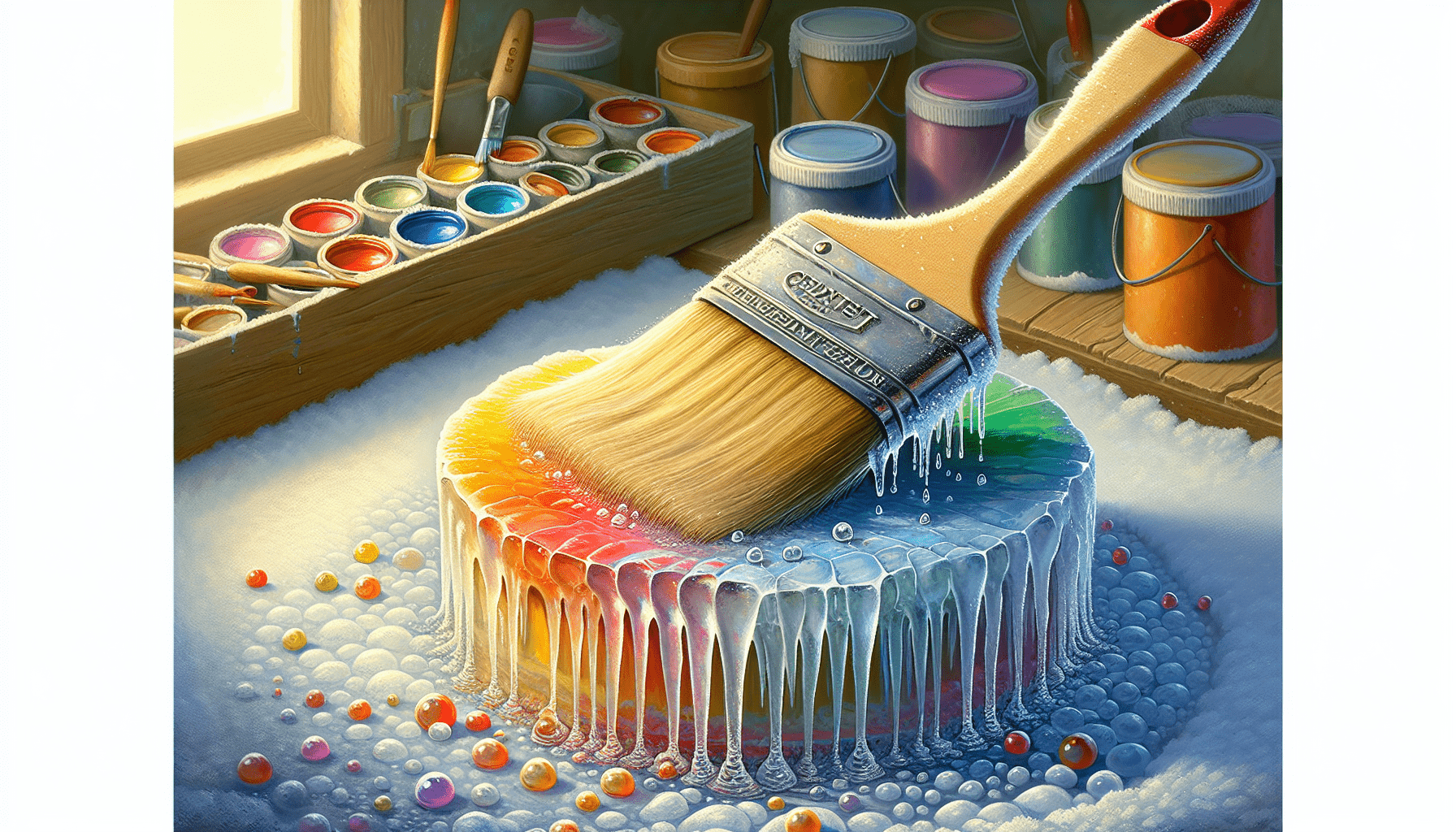When it comes to refinishing your furniture or giving your walls a fresh coat of paint, it’s crucial to consider the compatibility between different types of finishes. In this article, we explore the question of whether it is possible to spray lacquer over latex paint. With the aim of providing comprehensive insights, we delve into the factors that influence the success of this combination, such as surface preparation, product compatibility, and potential challenges. By understanding the dos and don’ts of this particular finishing technique, you can achieve professional-looking results while extending the lifespan of your painted surfaces.

Can You Spray Lacquer Over Latex Paint
When it comes to refinishing or protecting surfaces, many people wonder if it is possible to spray lacquer over latex paint. While it is technically possible, there are important considerations to keep in mind. In this article, we will explore the compatibility of lacquer and latex paint, the necessary preparation steps, the choice of lacquer, tools and equipment required, the application process, and the advantages and disadvantages of spraying lacquer over latex paint. By understanding these factors, you will have the knowledge necessary to make an informed decision.
Understanding Lacquer and Latex Paint
What is Lacquer?
Lacquer is a type of coating that provides a clear, durable, and glossy finish to surfaces. It is typically used on wood, metal, and other materials to enhance their appearance and protect them from damage. Lacquer can be applied using various methods, including brushing, rolling, and spraying. It is known for its quick drying time and versatility.
What is Latex Paint?
Latex paint, also known as acrylic paint, is a water-based paint that is widely used in both residential and commercial applications. It is easy to use, dries quickly, and provides a smooth and durable finish. Latex paint is commonly used on walls, ceilings, and other surfaces where a washable and low-odor option is desired.
Compatibility of Lacquer and Latex Paint
Chemical Properties
Lacquer and latex paint have different chemical properties, which can affect their compatibility. Lacquer is typically solvent-based and contains volatile organic compounds (VOCs) that allow it to dry quickly. On the other hand, latex paint is water-based and has lower VOC levels. These differences in composition can create challenges when trying to combine the two.
Adhesion
One of the crucial considerations in spraying lacquer over latex paint is adhesion. Proper adhesion ensures that the lacquer adheres securely to the surface without peeling or bubbling. While lacquer can adhere well to properly prepared latex paint surfaces, there is a risk of poor adhesion due to the differences in chemical composition. This potential lack of adhesion can lead to unsightly and unstable finishes.
Compatibility Issues
In addition to adhesion, there are other compatibility issues to consider when spraying lacquer over latex paint. Lacquer is known to be a strong solvent that can dissolve or soften certain types of paint. If the latex paint is not fully cured, the application of lacquer can cause the paint to react and result in a crackled or uneven finish. Furthermore, lacquer may cause the latex paint to become discolored or develop a yellowish tint over time.
Preparation for Spraying Lacquer over Latex Paint
To maximize the chances of a successful outcome, thorough preparation is essential when considering spraying lacquer over latex paint.
Surface Cleaning
Begin by thoroughly cleaning the painted surface to remove any dirt, grease, or contaminants. Use a mild detergent mixed with water and a soft cloth or sponge to cleanse the surface gently. Rinse with clean water and allow it to dry completely before proceeding.
Sanding
Next, sand the latex paint surface to create a rough texture that will improve adhesion. Use a fine-grit sandpaper or sanding block and apply even pressure. Sand in a circular motion until the surface feels slightly rough to the touch. Be sure to remove any sanding dust before moving on to the next step.
Priming
To enhance adhesion and improve compatibility, it is recommended to apply a layer of primer before spraying lacquer over latex paint. Choose a primer specifically designed for use with both lacquer and latex paint. Apply the primer according to the manufacturer’s instructions and allow it to dry thoroughly before proceeding with the lacquer application.

Choosing the Right Lacquer
When considering spraying lacquer over latex paint, it is crucial to choose the right type of lacquer for the job. There are two main types of lacquer available: water-based lacquer and solvent-based lacquer.
Water-Based Lacquer
Water-based lacquer, also known as acrylic lacquer, is a popular choice due to its low VOC content and ease of use. It offers a clear and durable finish and is less likely to cause discoloration or yellowing over time. Water-based lacquers also have a faster drying time compared to solvent-based alternatives. However, they may not adhere as well to latex paint surfaces, requiring additional surface preparation and testing for compatibility.
Solvent-Based Lacquer
Solvent-based lacquer, also known as nitrocellulose lacquer, has been a long-time favorite among professionals due to its superior adhesion and durability. It provides a high-gloss finish and is known for its excellent leveling properties, making it easier to achieve a smooth and flawless surface. However, solvent-based lacquers often contain higher levels of VOCs, have a longer drying time, and are more likely to cause discoloration over time. Proper ventilation is essential when working with solvent-based lacquers.
Selecting the Appropriate Tools and Equipment
To achieve the best results when spraying lacquer over latex paint, it is essential to have the appropriate tools and equipment.
Spray Gun
Investing in a high-quality spray gun is crucial for achieving a smooth and even finish. Look for a spray gun specifically designed for lacquer application and ensure it is compatible with the type of lacquer you have chosen. Consider factors such as air pressure control, nozzle size, and ease of use. Follow the manufacturer’s instructions for proper setup and maintenance of the spray gun.
Compressor
A reliable air compressor is necessary to provide the air pressure required for spraying lacquer. Make sure the compressor you choose can deliver a constant and consistent air supply. Consider factors such as tank size, maximum PSI (pounds per square inch), and noise level. Proper maintenance and regular monitoring of the compressor’s pressure and air quality are essential for optimal performance.
Protective Gear
When working with lacquer, it is crucial to protect yourself from harmful fumes and particles. Wear a respiratory mask rated for organic vapors to prevent inhalation of fumes. Additionally, wear safety goggles to protect your eyes from overspray and solvents. Disposable gloves can also be used to prevent direct skin contact with lacquer and ensure personal safety.
Application Process
Testing Compatibility
Before applying lacquer over latex paint, it is essential to perform a compatibility test in a small inconspicuous area. Prepare a sample area by cleaning, sanding, and priming it as described earlier. Spray a thin layer of lacquer and allow it to dry according to the manufacturer’s instructions. Inspect the test area for any signs of poor adhesion, cracking, bubbling, or discoloration. If the results are unsatisfactory, it is recommended not to proceed with spraying lacquer over the latex paint.
Priming the Surface
After confirming compatibility, apply a thin and even layer of primer over the latex paint surface. Use long, overlapping strokes to ensure uniform coverage. Allow the primer to dry completely before proceeding with the lacquer application. The primer serves as an additional layer of adhesion and compatibility between the latex paint and lacquer.
Applying Lacquer
Once the primed surface is fully dried, it is time to apply the lacquer. Begin by mixing the lacquer according to the manufacturer’s instructions. Load the spray gun with lacquer and adjust the air pressure according to the manufacturer’s recommendations. Hold the spray gun approximately 6-8 inches away from the surface and apply the lacquer using long and even strokes. Overlapping the strokes will help ensure an even and consistent application. Allow the lacquer to dry completely before applying additional coats if desired.
Tips and Recommendations
Spraying Techniques
To achieve a professional and flawless finish when spraying lacquer over latex paint, consider the following techniques:
- Maintain consistent and even pressure on the spray gun trigger throughout the application process.
- Keep the spray gun at a consistent distance from the surface to ensure even coverage.
- Use thin and multiple coats rather than a single heavy coat to avoid drips and sagging.
- Allow sufficient drying time between coats to prevent the risk of wrinkling or lifting.
Drying and Curing Time
Patience is key when working with lacquer. The drying and curing time can vary depending on environmental factors such as temperature and humidity. Follow the manufacturer’s instructions regarding drying and curing times. It is generally recommended to allow at least 24-48 hours for the lacquer to fully cure before subjecting the surface to heavy use or exposure to moisture.
Finishing Touches
Once the lacquer has fully dried and cured, you may consider applying a protective topcoat or wax to enhance its durability and appearance. This additional layer can provide extra protection against scratches, stains, and UV damage. Select a topcoat specifically designed for lacquer finishes and follow the manufacturer’s instructions for proper application.
Advantages and Disadvantages
Advantages of Spraying Lacquer over Latex Paint
- Enhanced durability and protection: Lacquer provides a robust and glossy finish that offers protection against wear, stains, and moisture.
- Improved appearance: The high-gloss finish of lacquer can enhance the visual appeal of surfaces, giving them a professional and polished look.
- Versatility: Lacquer can be used on a wide range of surfaces, including wood, metal, and even some plastics.
- Quick drying time: Lacquer dries quickly, allowing for faster project completion.
Disadvantages of Spraying Lacquer over Latex Paint
- Compatibility issues: Lacquer and latex paint have different chemical properties, which can lead to adhesion problems and potential damage to the underlying paint.
- Color and finish changes: Over time, lacquer may cause the latex paint to become discolored or develop a yellowish tint, altering the original appearance.
- Potentially higher VOC levels: Solvent-based lacquers can contain higher levels of volatile organic compounds, which may have environmental and health implications.
- Additional preparation and testing required: Spray lacquering over latex paint requires thorough surface preparation, compatibility testing, and potentially the use of a primer, adding extra time and effort to the project.
Conclusion
Spraying lacquer over latex paint is possible, but it requires careful consideration and preparation. Understanding the chemical properties and compatibility issues between lacquer and latex paint is essential for achieving a successful and durable finish. By following the recommended surface preparation steps, using the appropriate tools and equipment, and applying lacquer using proper techniques, you can achieve a professional and lasting result. However, it is important to weigh the advantages and disadvantages before proceeding, as the potential risks may outweigh the benefits in some cases. Ultimately, the choice of whether to spray lacquer over latex paint will depend on your specific project requirements and personal preferences.



